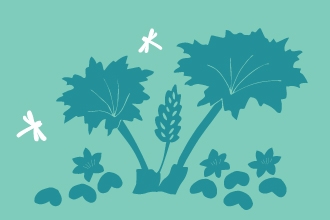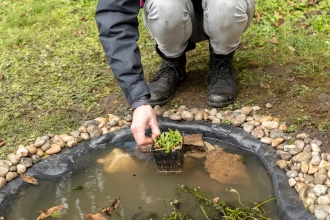Gardeners are being encouraged to install nest boxes and create habitats that boost insect numbers to help swallows, swifts, and martins as part of a new campaign.
Wild About Highflyers is a joint initiative by The Wildlife Trusts and the Royal Horticultural Society’s (RHS) Wild About Gardens campaign that aims to boost numbers of these charismatic migratory birds.
Swifts and house martins were recently added to the UK Red List, having suffered serious declines in recent decades. It is estimated that almost 60% of UK swifts have disappeared over the last 25 years.
Huge declines of insects, habitat loss, and the impacts of climate change – with extreme weather affecting breeding cycles and migration – are the main challenges affecting migratory birds.
A new campaign guide provides gardeners with tips on how they can help swallows, swifts, and martins. Suggestions include:
- Creating a ‘bog garden’ with plants like marsh-bedstraw and purple loosestrife. Bog gardens provide valuable habitat for frogs, dragonflies, and a wealth of insects, as well as materials that swallows and house martins can use to build nests.
- Adding a swift box to an existing house or including a swift brick in any kind of new build. Ideally, swift boxes face north/north-east to help regulate the internal temperature and are at least five metres above ground.
- Letting a patch of grass grow long, providing vital habitat and food for insects and other wildlife.
Dr Rob Stoneman, Director of Landscape Recovery at The Wildlife Trusts, says:
“Swifts, swallows, and martins are some of our most iconic breeding birds. Watching and hearing these creatures soar through the sky is an uplifting spectacle, and an experience that leaves you totally in awe of nature. Sadly, these birds – like much of our wildlife – have suffered severe declines in recent decades due to habitat loss and plummeting insect numbers, which are affected by pollution, the impacts of development, and climate change.
“With a bit of diversity and structure, a garden can become a haven for all kinds of wildlife, providing nesting sites, shelter and food. It’s all about being creative, ditching all chemicals, and letting things go a bit wild. If we can encourage enough gardeners to give a bit of their garden over to wildlife, it could work wonders for the natural world, which means more insects for swallows and more enjoyment of wildlife for people.”
Helen Bostock, Senior Wildlife Specialist at the RHS, says:
“Anyone lucky enough to share their homes with nesting swallows, swifts or house martins will understand how magical these birds are. But also how vulnerable; with the numbers of those returning each summer dropping year on year. The UK’s 30 million gardeners have an important part to play in helping revive their populations - from tailoring planting choices to include insect favourites and embracing bare patches for the benefit of nest building, people can make small scale changes that will reap big rewards. How sad it would be if future generations never know the joy of seeing these wonderful birds in our gardens and green spaces.”
Facts about swifts, swallows, and martins:
Swifts:
- Are often heard before they are seen. They have a distinctive screaming call, and groups darting through the sky – often at dusk – are known as “screaming parties”.
- Although they used to nest in caves and trees, swifts have adapted to make their homes in towns and cities.
- Form what is known as a “bolus” at the back of their throats, where they store flying insects that they catch on the wing. They can catch up to 20,000 insects in a day.
- Can reach speeds over 65mph, making them the fastest recorded bird in level flight.
Swallows
- Migrate to South Africa on a dangerous journey that can take up to six weeks.
- Are often found close to water and can be seen in meadows and farmland.
- When looking for a mate, females will go for the male with the longest and most symmetric tale, which is a sign of good health. They also mate for life.
House martins
- Are a colonial species, so they tend to nest in groups of around five nests.
- Like swallows, they are among the few birds that build their nests from mud, using wet earth and grasses to create a home they can return to year after year.
- Are notoriously difficult to track throughout their migration process - there's only ever been one UK-ringed house martin recorded in Africa, back in 1984!
Sand martins
- Are found along rivers, on wetlands, and in quarries, where they nest in colonies, digging burrows in sandy cliffs.
- In the last 50 years, populations have plummeted due to drought in Africa, where they spend the winter.
The launch of Wild About Highflyers will be complemented by a series of talks and practical demonstrations at RHS Hilltop: the Home of Gardening Science at RHS Garden Wisley on 23rd and 24th March. For more information visit: www.rhs.org.uk
For more information on the campaign, and to download the guide, visit: wildaboutgardens.org.uk



